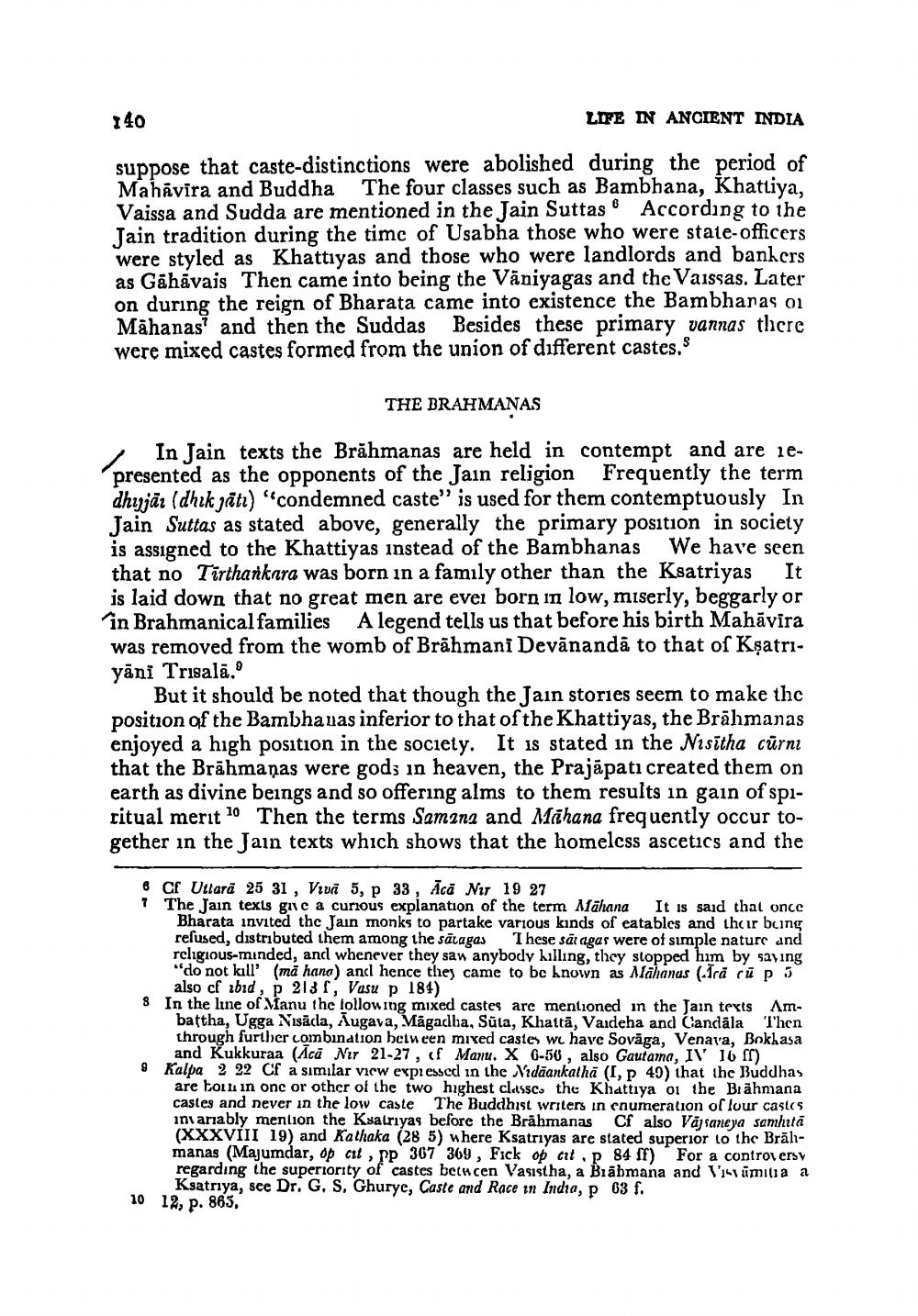________________
140
LIFE IN ANCIENT INDIA
suppose that caste-distinctions were abolished during the period of Mahavira and Buddha The four classes such as Bambhana, Khattiya, Vaissa and Sudda are mentioned in the Jain Suttas & According to the Jain tradition during the time of Usabha those who were state-officers were styled as Khattiyas and those who were landlords and bankers as Gähāvais Then came into being the Vāniyagas and the Vaissas. Later on during the reign of Bharata came into existence the Bambharas oi Māhanas? and then the Suddas Besides these primary vannas there were mixed castes formed from the union of different castes.
THE BRAHMANAS
In Tain texts the Brahmanas are held in contempt and are lepresented as the opponents of the Jain religion Frequently the term dhıyjāı (dhuk Jati) condemned caste" is used for them contemptuously In Jain Suttas as stated above, generally the primary position in society is assigned to the Khattiyas instead of the Bambhanas We have seen that no Tirthankara was born in a family other than the Ksatriyas It is laid down that no great men are ever born in low, miserly, beggarly or in Brahmanicalfamilies A legend tells us that before his birth Mahāvira was removed from the womb of Brāhmani Devānandā to that of Kșatrıyāni Trisalā.'
But it should be noted that though the Jain stories seem to make the position of the Bambhanas inferior to that ofthe Khattiyas, the Brāhmanas enjoyed a high position in the society. It is stated in the Nisītha cūrni that the Brāhmaṇas were god; in heaven, the Prajapati created them on earth as divine beings and so offering alms to them results in gain of spiritual merit 10 Then the terms Samena and Mihana frequently occur together in the Jain texts which shows that the homeless ascetics and the
6 Cf Uttară 25 31 , Viva 5, p 33, Ācā Nir 19 27 7 The Jain texts guc a curious explanation of the term Māhana It is said that once
Bharata invited the Jain monks to partake various kinds of eatables and their being refused, distributed them among the sālagas Ihese säragas were of simple nature and religious-minded, and whenever they saw anybody killing, they stopped him by saying
do not kill' (må hano) and hence they came to be known as Mlāhanas (Iră cū p5
also cf zbid, p 2137, Vasu p 181) 8 In the line of Manu the following mixed castes are mentioned in the Jain texts Am
battha, Ugga Nisāda, Augava, Māgacha, Süla, Khattā, Vaideha and Candala Then through further combination between mixed castes we have Sovāga, Venava, Bokhasa
and Kukkuraa (cā Nir 21-27, of Manu. X 6-50, also Gautama, IV 16 ff) 9 Kalpa 3 22 Cf a similar view expressed in the Nidaankathā (I, 49) that the Buddhas
are born in one or other of the two highest classc. the Khattıya 01 the Brahmana castes and never in the low caste The Buddhist writers in cnumeration of lour castes invariably mention the Ksatriyas before the Brahmanas Cf also Väy saneya samhita (XXXVIII 19) and Kathaka (28 5) where Ksatriyas are stated superior to the Brālimanas (Majumdar, op cit, pp 367 369, Fick op aut.p 84 ff) For a controversy regarding the superiority of castes betucen Vasistha, a Biābmana and Vis ūmilia a
Ksatriya, sce Dr. G. S, Ghurye, Caste and Race in India, p 63 f. 10 12, p. 865,




